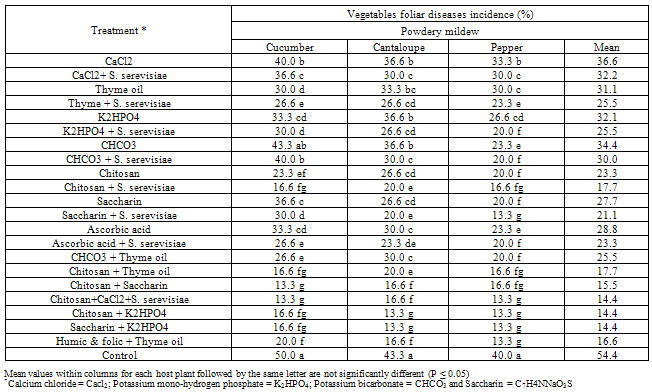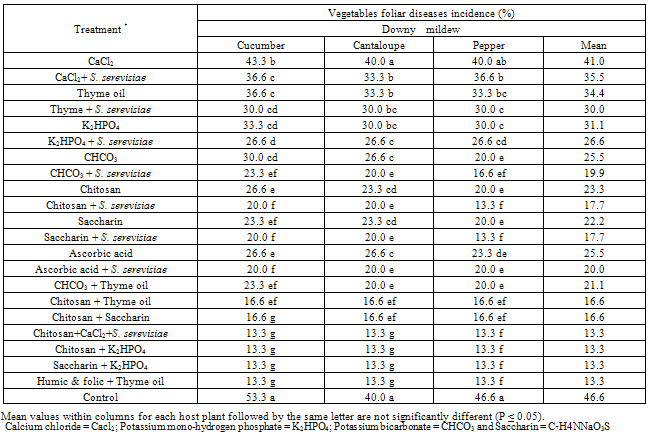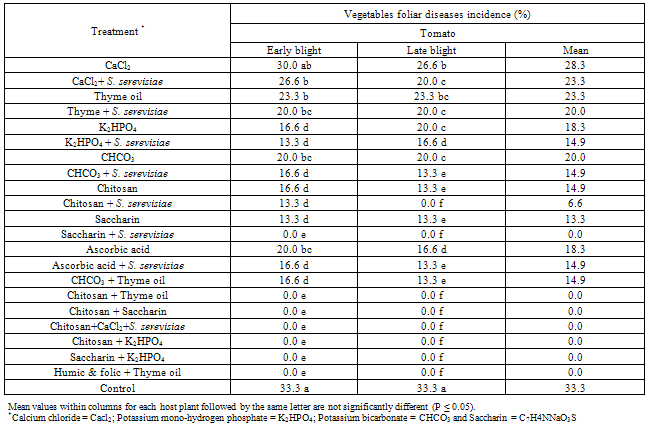| [1] | Anonymous, 2009, ‘Yearbook of statistics of Ministry of Agriculture.’ Agricultural Economical and Statistical Department, Arab Republic of Egypt: Cairo, (2009), [In Arabic] |
| [2] | Kiss, L., 2003, A review of fungal antagonists of powdery mildews and their potential as biocontrol agents. Pest Manage Sci., 59,475-483. |
| [3] | Zhinong, Y., Reddy, M.S., Choong-Min, R.; John A. M.; Wilson, M. and Kloepper, J.W. 2002. Induced Systemic Protection Against Tomato Late Blight Elicited by Plant Growth-Promoting Rhizobacteria. Pytopathology, 92, (12), 1329-1333. |
| [4] | Jagadeesh, K.S., Jagadeesh, D.R., 2009, Biological control of early blight of tomato caused by Alternaria solani as influenced by different delivery methods of Pseudomonas gladioli B25. Acta Horticulture, 808, 327-332. |
| [5] | Chet I, Inbar J and Hadar I. 1997. Fungal antagonists and mycoparasites. In: The Mycota IV: Environmental and Microbial Relationships. Wicklow DT and Soderstorm B, eds. pp 165-184. |
| [6] | Kamilova, F., Validov, S., Lugtenberg, B., 2009, Biological Control of Tomato foot and root rot caused by Fusarium oxysporum f.sp. radicis-lycopersici by Pseudomonas bacteria. Acta Hort. (ISHS), 808,317-320. |
| [7] | Tehrani, S.A., Ramezani, M., 2003, Biological control of Fusarium oxysporum, the causal agent of onion wilt by antagonistic bacteria. Agric. Appl. Biol Sci., 68,(4),543-547. |
| [8] | Dik, A., Wubben, J., Elad, Y., Kohi, J., Shtienberg, D., 2002, Combination of control methods against powdery mildew diseases in glasshouse-grown vegetables and ornamentals. Bull. OIL B-SROP, 25, (10),5–8. |
| [9] | Zinkernagel, V., Tischner, H., Hausladen, H., Habermeyer, H., Taborsky, V., Polak, J., Lebeda, A., Kudela, V., 2002, Practical application of integrated disease management. Plant Prot. Sci., 38, 212–222. |
| [10] | Napier, D., Oosthuyse, S.A., 2000, Use of monopotassium phosphate in the integrated control of powdery mildew. Rivista di Frutticoltura e di Ortofloricoltura, 62, (6), 57–58. |
| [11] | Belanger, R.R., Dik, A.J., Menzies, J.G., 1997, Powdery mildew: Recent advances towards integrated control. In: Boland GS, Kuykendall LD (eds) Plant-microbe interactions and biological control. Marcel Dekker, New York, USA, (1997), pp. 89-109. |
| [12] | Reuveni, M., Agapov, V., Reuveni, M., Raviv, M., 1994, Effects of foliar sprays of phosphates on powdery mildew (Sphaerotheca pannosa) of roses. J. Phytopathol. (Berlin), 142, 331–337. |
| [13] | Reuveni, M., Agapov, V., Reuveni, R., 1995, Suppression of cucumber powdery mildew (Sphaerotheca fuliginea) by foliar sprays of phosphate and potassium salts. Plant Pathol. (London), 44, 31–39. |
| [14] | Reuveni, M., Agapov, V., Reuveni, M., 1996, Controlling powdery mildew caused by Sphaerotheca fuliginea in cucumber by foliar sprays of phosphate and potassium salts. Crop Prot., 15, 49–53. |
| [15] | Ziv, O., Zitter, T.A., 1992, Effects of bicarbonates and film forming polymers on cucurbit foliar diseases. Plant Dis., 76, 513–517. |
| [16] | Ziv, O., Hagiladi, A., 1993, Controlling of powdery mildew in Euonymus with polymer coatings and bicarbonate solutions. Hort. Science, 28, 124–126. |
| [17] | El-Mougy, N.S., Abdel-Kader, M.M., 2009, Salts application for suppressing potato early blight. Journal of Plant Protection Research, 49, (4), 353-361. |
| [18] | Mucharromah, E., Kuc, J., 1991, Oxalates and phosphates induce systemic resistance against disease caused by fungi, bacteria and viruses in cucumber. Crop Prot., 10, 265–270. |
| [19] | Yamazaki, H., Hoshima, T., 1995, Calcium nutrition affects resistance of tomato seedlings to bacterial wilt. Hort. Science, 30, 91–93. |
| [20] | El-Mougy, N.S., Abdel-Kader, M.M., Abdel-Kareem, F., Embaby, E.I., El-Mohamady, R., Abd El-Khair, H., 2011, Survey of Fungal Diseases Affecting Some Vegetable Crops and Their Rhizospheric Soilborne Microorganisms Grown under Protected Cultivation System in Egypt. Research Journal of Agriculture and Biological Sciences, 7,(2), 203-211. |
| [21] | SAS, Institute Inc., ‘SAS/STAT user’s guide. Version 6. Vol. 2.’ 12th edn. (SAS Institute Inc.: Cary, NC), (1996), 846 pp. |
| [22] | Winer, B.J., ‘Statistical principles in experimental design.’ 2nd edn. (McGraw-Hill Kogakusha Ltd: Tokyo), (1971), 596 pp. |
| [23] | Roinestad, K.S., Montville, T.J., Rosen, J.D., 1993, Inhibition of trichothecene biosynthesis in Fusarium tricinctum by sodium bicarbonate. J. Agric. Food Chem. 41, 2344–2346. |
| [24] | Singh, S.N., Chand, L., 1993, Inhibition of aflatoxin production by garlic extract and sodium bicarbonate. Crop Res., 6, 149–154. |
| [25] | Ashour, A.M.A., 2009, Effect of Application of some Systemic Fungicides and Resistance Inducing Chemicals on Management of Cantaloupe Powdery Mildew Disease._ _Egypt. J. Phytopathol., 37, (1),____ 1-8. |
| [26] | Palmer, C.L., Horst, R.K., Langhans, R.W., 1997, Use of bicarbonate to inhibit in vitro colony growth of Botrytis cinerea. Plant Dis., 81, 1432–1438. |
| [27] | Palou, L., Smilanick, J.L., Usall, J., Vinas, I., 2001, Control of postharvest blue and green molds of oranges by hot water, sodium carbonate and sodium bicarbonate. Plant Dis., 85, 371–376. |
| [28] | Qin, G.Z., Tian, S.P., Xu, Y., Chan, Z.L, Li, B.Q., 2006, Combination of antagonistic yeasts with two food additives for control of brown rot caused by Monilinia fructicola on sweet cherry fruit. Journal of Applied Microbiology, 100, 508–515. |
| [29] | Smilanick, J.L., Margosan, D.A., Mlikota, F., Usall, J., Michael, I.F., 1999, Control of citrus green mold by carbonate and bicarbonate salts and the influence of commercial postharvest practices on their efficacy. Plant Dis., 83,139-145. |
| [30] | Wisniewski, M., Wilson, C., El Ghaouth, A., Droby, S., 2001, Increasing the ability of the biocontrol product, Aspire, to control postharvest diseases of apple and peach with the use of additives. Biological control of fungal and bacterial plant pathogens. IOBC/WPRS Bull., 24, (3), 157–160. |
| [31] | Janisiewicz, W.J., Peterson, D.L., 2005, Experimental Bin drenching system for testing biocontrol agents to control postharvest decay of apples. Plant Dis., 89, 487–490. |
| [32] | Petersson, S., Schnurer, J., 1995, Biocontrol of mold growth in high moisture wheat stored under airtight conditions by Pichia anomala, Pichia guilliermondii, and Saccharomyces cerevisiae. Appl. Environ. Microbiol., 61,(3), 1027–1032. |
| [33] | Conway, W.S.0., Sams, C.E., 1985, Influence of fruit maturity on the effect of postharvest calcium treatment on decay of Golden Delicious apples. Plant Disease, 69, 42–44. |
| [34] | Conway, W.S., Abbott, J.A., Bruton, B.D., 1991, Postharvest calcium treatment of apple fruit to provide broad-spectrum protection against postharvest pathogens. Plant Disease, 75, 620–622. |
| [35] | Conway, W.S., Sams, C.E., McGuire, R.G., Kelman, A., 1992, Calcium treatment of apples and potatoes to reduce postharvest decay. Plant Disease, 76, 329–333. |
| [36] | Wisniewski, M., Droby, S., Chalutz, E., Eilam, Y., 1995, Effects of Ca2+ and Mg2+ on Botryris cinerea and Penicillium expansum in vitro and on the biocontrol activity of Candida oleophila. Plant Pathology, 44, 1016–1024. |
| [37] | Saftner, R.A., Conway, W.S., Sams, C.E., 1997, Effects of some polyamine biosynthesis inhibitors and calcium chloride on in vitro growth and decay development in apples caused by Botrytis cinerea and Penicillium expansum. J. Am. Soci. Hort. Sci., 122, 380–385. |
| [38] | Tian, S.P., Fan, Q., Xu, Y., Jiang, A.L., 2002, Effects of calcium chloride on biocontrol activity of yeast antagonists against the postharvest fungal pathogen Rizopus stolonifer. Plant Pathol., 51, 352–358. |
| [39] | Venette, J.R., 1998, Calcium micronutrient may reduce white mold of dry beans. Proceedings of the Sclerotinia Workshop, Minnesota ND, In-Service Extension Worksho, Fargo. |
| [40] | Gulya, T.J., Miller, J.F., 2007, Advances in the development of sunflower germplasm with resistance to both Sclerotinia stalk rot and head rot, and the possible role of calcium in Sclerotinia resistance. Proceedings of the 2007 National Sclerotinia Initiative Annual Meeting, Minneapolis. |
| [41] | Paula Júnior, T.J., Vieira, R.F., Teixeira, H., Carneiro, J.S., 2009, Foliar application of calcium chloride and calcium silicate decreases white mold intensity on dry beans. Tropical Plant Pathology, 34, (3), 171-174. |
| [42] | Siegrist, J., Muhlenbeck, S., Buchenauer, H., 1988, b- aminobutyric acid-mediated enhancement of resistance in tobacco to tobacco mosaic virus depends on the accumulation of salicylic acid. Physiol. Mol. Plant Pathol., 53,223–228. |
| [43] | Boyle, C., Walters, D., 2005, Induction of systemic protection against rust infection in broad bean by saccharin: effects on plant growth and development. New Phytol., 167,607–612. |
| [44] | Boyle, C., Walters, D.R., 2006, Saccharin-induced resistance to powdery mildew in barley: effects on growth and phenylpropanoid metabolism. Plant Pathol., 55,82–91. |
| [45] | Trotel-Aziz, P., Couderchet, M., Vernet, G., and Aziz, A., 2006, Chitosan stimulates defense reactions in grapevine leaves and inhibits development of Botrytis cinerea. Eur. J. Plant Pathol., 114,405-413. |
| [46] | Aziz, A., Trotel-Aziz, P., Dhuicq, L., Jeandet, P., Couderchet, M., Vernet, G., 2006, Chitosan Oligomers and Copper Sulfate Induce Grapevine Defense Reactions and Resistance to Gray Mold and Downy Mildew. Phytopathology, 96,1189-1194. |
| [47] | Chang, M.M., Hadwiger, L.A., Horovitz, D., 1992, Molecular characterization of a pea beta-1,3-glucanase induced by Fusarium solani and chitosan challenge. Plant Mol. Biol., 20,609-618. |
| [48] | Hadwiger, L.A., Tomoya, O., Hiroki, K.H., 1994, Chitosan polymer sizes effective in inducing phytoalexin accumulation and fungal suppression are verified with synthesized oligomers. Mol. Plant-Microbe Interact., 7,531-533. |
| [49] | Hadwiger, L.A., McBride, P.O., 2006, Low-level copper plus chitosan applications provide protection against late blight of potato. Online, Plant Health Progress, doi:10.1094/PHP- 2006-0406-01-RS. |
| [50] | Atia, M.M.M., Buchenauer, H., Aly, A.Z., Abou-Ziad, M.I., 2005, Antifungal activity of chitosan against Phytophthora infestans and activation of defence mechanisms in tomato to late blight. Biological agriculture & horticulture, 23, 175-197. |
| [51] | Chircov, S.N., 2002, The antiviral activity of chitosan (review). Applied Biochemistry and Microbiology, 38, 1–8. |
| [52] | Rabea, E.I., Badawy, M.E.I., Stevens, C.V., Smagghe, G., Steurbaut, W., 2003, Chitosan as antimicrobial agent: applications and mode of action. Bio macro molecules, 4, 1457–1465. |
| [53] | Zheng, L., Zhu, J., 2003, Study on antimicrobial activity of chitosan with different molecular weights. Carbohydrate Polymer, 54, 527–30. |
| [54] | Scheuerell, S.J., Mahaffee, W.H., 2006, Variability Associated with Suppression of Gray Mold (Botrytis cinerea) on Geranium by Foliar Applications of Nonaerated and Aerated Compost Teas. Plant Dis., 90, 1201-1208. |
| [55] | Abd-El-Kareem, F., 2007, Induced resistance in bean plants against root rot and Alternaria leaf spot diseases using biotic and abiotic inducers under field conditions. Research J. Agricultural and Biological Science, 3,(6), 767-774. |
| [56] | Atiyeh, R.M., Lee, S., Edwards, C.A., Arancon, N.Q., Metzger, J.D., 2002, The influence of humic acids derived from earthworm processed organic wastes on plant growth. Bioresource Technology, 84, 7-14. |
| [57] | Chen, Y., Nobili and T. Aviad, 2004. Stimulatory effect of humic substances on plant growth. In "Soil organic matter in sustainable agriculture". (Eds F. Magdoff, R.R. Weil), 103-130, Boca Raton, FL. Dewis, J. and F. Freitas, (1970), "Physical and chemical methods of soil and water and analsis " food and agriculture organization of United Nations, Rome. |
| [58] | Piccolo, A., Nardi, S., Concheri, G., 1992, Structural characteristics of humic substances as regulated to nitrate uptake and growth regulation in plant systems. Soil Biochem., 24, 373-380. |
| [59] | Zhang, X., 1997, Influence of plant growth regulators on turfgrasss growth, antioxidant status, and drought tolerance. Ph.D. thesis, Fac. Of Virginia Polytechni (Institute and State University). |
| [60] | Ziadi, S., Barbedette, S., Godard, J.F., Monoti, C., Corre, L.E.D., Silue, D., D. Lecorre, 2001, Production of pathogenesis related protein in the cauliflower (Brassica oleacea var. botrytis) downy mildew (Peronospora parasistica) pathosystem treated with acidbenzolar-5-methyl. Plant Pathol., 50, (5), 579-586. |
| [61] | Dmitrier, A., Tena, M., Jorrin, J., 2003, Systemic acyuired resistance in sunflower (Helianthus annuus L.). Tsitologiya-1-Genetika, 37,(3), 9-15. |
| [62] | Achuo, E.A., Audenaert, K., Meziana, H., Hofte, M., 2004, The salicylic acid dependent defence pathway is effective against different fungi in tomato and tobacco. Plant Pathol., 53, 65-72. |
| [63] | Yang, V.W., Clausen, C.A., 2007, Antifungal effect of essential oils on southern yellow pine. International Biodeterioration & Biodegradation, 59, 302–306. |
| [64] | Momol, M.T., Olson, S.M., Pradhanang, P.M., Jones, J.B., 2005, Evaluation of thymol as biofumigant for control of bacterial wilt of tomato under field conditions. Plant Dis., 89,497-500. |
| [65] | Paster, N., Menasherov, M., Ravid, U., Juven, B., 1995, Antifungal activity of oregano and thyme essential oils applied as fumigants against fungi attacking stored grain. J. Food Prot., 58,81-85. |
| [66] | Liu, W.T., Chu, C.L., Zhou, T., 2002, Thymol and acetic acid vapors reduce postharvest brown rot of apricots and plums. Hort. Science, 37,151-156. |
| [67] | Juven, B.J., Kanner, J., Schved, F., Weisslowicz, H., 1994, Factors that interact with the antibacterial action of thyme essential oil and its active constituents. J. Appl. Bacteriol., 76, 626-631. |
| [68] | Walsh, S. E., Maillard, J.Y., Russell, A.D., Catrenich, C.E., Charbonneau, D.L., Bartolo, R.G., 2003, Activity and mechanisms of action of selected biocidal agents on Gram positive and negative bacteria. J. Appl. Microbiol., 94,240-247. |
| [69] | Pradhanang, P.M., Momol, M.T., Olson, S.M., Jones, J.B., 2003, Effects of plant essential oils on Ralstonia solanacearum population density and bacterial wilt incidence in tomato. Plant Dis., 87,423-427. |
| [70] | Droby, S., Chalutz, E., Wilson, C.L., Wisniewski, M., 1989, Characterization of the biocontrol activity of Debaryomyces hansenii in the control of Penicillium digitatum of grapefruit. Can. J. Microbiol., 35, 794–800. |
| [71] | Janisiewicz, W.J., Tworkoski, T.J., Sharer, C., 2000. Characterizing the mechanism of biological control of postharvest diseases on fruits with a simple method to study competition for nutrients. Phytopathology, 90, 1196–1200. |
| [72] | El-Ghaouth, A., Wilson, C.L., Wisniewski, M., 1998, Ultrastructural and cytochemical aspects of the biological control of Botrytis cinerea by Candida saitoana in apple fruit. Phytopathology, 88, 282–291. |
| [73] | Arras, G., 1996, Mode of action of an isolate of Candida famata in biological control of Penicillium digitatum in orange fruits. Postharvest. Biol. Technol., 8, 191–198. |
| [74] | Droby, S., Vinokur, V., Weiss, B., Cohen, L., Daus, A., Goldschmidt, E.E., Porat, R., 2002, Induction of resistance to Penicillium digitatum in grapefruit by the yeast biocontrol agent Candida oleophila. Phytopathology, 92, 393–399. |
| [75] | Droby, S., Wisniewski, M., El-Ghaouth, A., Wilson, C., 2003, Influence of food additives on the control of postharvest rots of apple and peach and efficacy of the yeast based biocontrol product Aspire. Postharvest Biol. Technol., 27,127–135. |
| [76] | El-Ghaouth, A., Smilanick, J.L., Brown, G.E., Ippolito, A., Wisniewski, M., Wilson, C.L., 2000, Applications of Candida saitoana and glycolchitosan for the control of postharvest diseases of apple and citrus fruit under semi- commercial conditions. Plant Dis., 84, 243–248. |
| [77] | Lima G., Castoria R., Spina A.M., De Curtis, F., 2005, Improvement of biocontrol yeast activity against postharvest pathogens: recent experiences. Acta Hortic., 682, 2035–2040. |
| [78] | Conway, W.S., Leverentz, B., Janisiewicz, W.J., Saftner, R.A., Camp, M.J., 2005, Improving biocontrol using antagonist mixtures with heat and/or sodium bicarbonate to control postharvest decay of apple fruit. Postharvest Biol. Technol., 36, (3), 235–244. |
| [79] | Hajlaoui, M.R., Belanger, R.R., 1993, Antagonism of the yeast like phylloplane fungus Sporothrix flocculosa against Erysiphe graminis var tritici. Biocontrol Sci. Technol., 11, 427-434. |
| [80] | Punja, Z.K., 1997, Comparative efficacy of bacteria, fungi and yeasts as biological control agents for disease of vegetable crops. Can. J. Plant Pathol., 19, 35-323. |
| [81] | Benyagoub, M., Rhlid, R.B., Belanger, R.R., 1996, Purification and characterization of new fatty acids with antibiotic activity produced by Sporothrix flocculosa. J. Chem. Ecol., 22, 405-413. |




 Abstract
Abstract Reference
Reference Full-Text PDF
Full-Text PDF Full-Text HTML
Full-Text HTML

